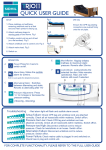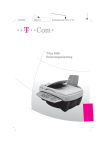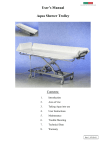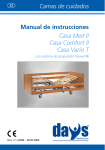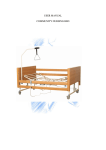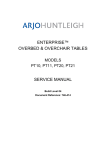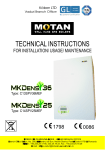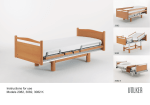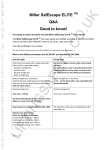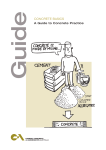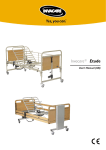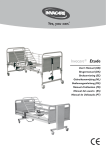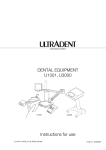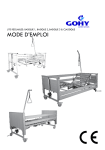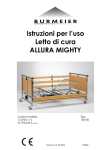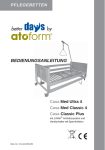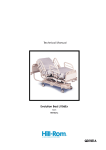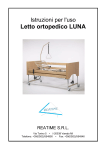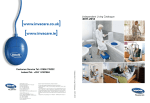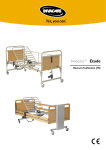Download - John Preston Healthcare Group
Transcript
NURSING BEDS OPERATING MANUAL Casa Med Classic FS ® with DEWERT drive systems Doc.-No.: E1-04-143-001 NURSING BEDS Introduction All Days Healthcare nursing beds are manufactured using the most modern technical facilities to ensure the highest lying and operating comfort possible. Furthermore, the construction has been designed placing great value on simple handling and operation. The nursing beds described in this manual are constructed to the following standards: DIN EN 1970 - 2000 (standard for nursing beds) and DIN EN 60601-2-38 (standard for hospital beds) in addition. Since the nursing bed motor system has a control system with a clock frequency of > 9 kHz, and is mainly driven by motor for short periods, EN 55014-1 applies in this case in accordance with EN 60601-1-2 36.201.1.4. A large variety of useful accessories rounds off our range of nursing beds. This operating manual will help you get to know the function of our nursing beds and, in addition, describes • assembling the nursing bed • operating the adjustment controls • care and maintenance of the nursing bed The manual has been drawn up using information available at the time of printing with regard to construction and operation of the nursing bed. We reserve the right to make changes due to technical improvements. If you have any other questions about this nursing bed, please contact your supplier. Casa Med Classic FS 3 Issued: 25.07.2007 NURSING BEDS 1.0 2.0 3.0 4.0 5.0 6.0 7.0 Contents Safety instructions ............................................................................. 7 1.1 Symbols used .............................................................................. 7 1.2 Proper use ................................................................................... 7 1.3 General information ...................................................................... 7 1.4 Notes on electrical fittings ........................................................... 8 1.5 Notes for nursing personnel, attendants and operator .................. 9 1.6 Notes on setting up the nursing beds ......................................... 10 1.7 Notes on maintenance and inspection ........................................ 11 Nursing bed model .......................................................................... 12 Extent of delivery ............................................................................. 12 Components ..................................................................................... 15 Fittings: bed frame ........................................................................... 15 5.1 Bed rails .................................................................................... 15 5.2 Mattress support ....................................................................... 16 5.3 Angle adjustment foot section (Rastomat) ................................. 16 5.4 Bed ends ................................................................................... 16 Fittings: Electrics ............................................................................. 17 6.1 Lift motor ................................................................................... 17 6.2 Hand set .................................................................................... 17 6.2.1 Hand set locking function ............................................... 17 6.3 Mattress support motor ............................................................. 18 6.4 Control unit ................................................................................ 18 Setting up the nursing bed .............................................................. 19 7.1 Location selection and space requirements ............................... 19 7.2 Preparation - only when supplied with transport and storage system .......................................................................... 20 7.3 Connecting the mattress support head and foot section ............ 20 7.4 Fixing the bed ends ................................................................... 21 7.5 Connecting the lift motor, hand set, mattress support motor and Accumulator box ................................................................. 22 7.6 Inserting the mattress support motor with control unit ............... 24 7.7 Assembly of accumulator box to the nursing bed (only nursing beds with Trendelenburg’s position) ....................... 25 7.8 Inserting the mattress support motor for foot section adjustment 26 7.9 Routing and fixing the control unit mains cable .......................... 27 7.10 Routing the electrical element cables ......................................... 28 7.11 Routing the hand set cable ........................................................ 29 7.12 Carrying out a performance test ................................................. 29 7.13 Installing the bed rails ................................................................ 30 7.14 Installing the patient pole ........................................................... 31 4 Issued: 25.07.2007 Casa Med Classic FS NURSING BEDS Contents 8.0 Safety devices .................................................................................. 32 8.1 Control unit ................................................................................ 32 8.2 Accumulator box (only nursing beds with Trendelenburg’s position) ....................... 33 8.2.1 General information ......................................................... 33 8.2.2 Charging the accumulator box ........................................ 33 8.2.3 Storage of the accumulator box ...................................... 33 8.3 Headrest adjustment emergency unlocking ................................ 34 9.0 Operating the nursing bed .............................................................. 35 9.1 General notes on operation ........................................................ 36 9.2 Plugging in the mains cable ....................................................... 36 9.3 Raising or lowering the bed rails ................................................. 37 9.4 Locking the function keys for the nursing bed adjustments ........ 38 9.4.1 Magnetically locking/unlocking the hand set function keys (hand set without Trendelenburg) ..................................... 40 9.4.2 Magnetically locking/unlocking the hand set function keys (hand set with Trendelenburg) .......................................... 41 9.4.3 Mechanically locking/unlocking the hand set function keys (hand set without Trendelenburg) ..................................... 42 9.4.4 Mechanically locking/unlocking the hand set function keys (hand set with Trendelenburg) .......................................... 43 9.4.5 Mechanically locking/unlocking the hand set function keys (programmable hand set without and with Trendelenburg) .. 44 9.4.6 Programming the function keys ...................................... 45 9.5 Operating the nursing bed adjustments ...................................... 46 9.5.1 Hand set ......................................................................... 46 9.5.2 Hand set with Trendelenburg’s position ............................ 47 9.6 Adjusting the foot section (Rastomat) ........................................ 48 9.7 Operating the brakes .................................................................. 49 9.8 Pushing the nursing bed and patient transport ........................... 49 9.9 Adjusting the slatted frame springiness ..................................... 50 10.0 Patient-related safety measures and adjustments made by nursing personnel ........................................................................... 51 10.1 Limits of use .............................................................................. 51 10.2 Gap dimensions and bed rail spacing ......................................... 51 10.3 Locking the nursing bed adjustments at the hand set ................ 52 11.0 Cleaning ........................................................................................... 52 12.0 Testing plan for nursing beds ......................................................... 53 12.1 Daily checks .............................................................................. 52 12.2 6-monthly inspection - check control unit ................................... 55 Casa Med Classic FS 5 Issued: 25.07.2007 NURSING BEDS 13.0 14.0 15.0 16.0 17.0 Contents 12.3 Testing intervals ......................................................................... 54 12.4 Inspection of mechanical components ....................................... 55 12.5 Inspection of electrical components ........................................... 57 12.6 Measurements ........................................................................... 58 Troubleshooting ............................................................................... 59 Storage of the nursing bed with the transport and storage system (TLSU) ............................................................................................... 60 14.1 Dismantling the nursing bed ....................................................... 60 14.2 Placing the components in the transport and storage system .... 64 Disposal ............................................................................................ 65 Appendix .......................................................................................... 66 16.1 Specifications: nursing bed ........................................................ 66 16.2 Specifications: Drive system ..................................................... 67 16.3 Nursing bed labelling .................................................................. 67 16.3.1 Nameplate ...................................................................... 67 16.3.2 Patient pole component sign ........................................... 68 16.4 Accessories ............................................................................... 68 16.5 Spare parts ................................................................................ 68 Warranty ............................................................................................ 69 6 Issued: 25.07.2007 Casa Med Classic FS NURSING BEDS Safety information 1.0 Safety instructions 1.1 Symbols used This instruction manual contains the following symbols which are used to highlight special hazards in dealing with the nursing bed or information for simplifying handling of the nursing bed. Caution! This symbol identifies safety information which notifies you of hazards when dealing with the product NOTE You will also find information about dealing with the product under this symbol. 1.2 Proper use Days Healthcare nursing beds are intended for continuous use instead of household beds. They are intended for use in alleviation or compensation of a handicap or inability and for making the working conditions of nursing personnel easier. Days Healthcare nursing beds are only approved for use by persons of over 12 years of age due to their complexity. The nursing beds are intended for use in: • home nursing • nursing home and rehabilitation institutions 1.3 General information Before assembling or using the nursing bed, please read this operating manual carefully through! Ensure that: • the complete operating manual is read by all persons entrusted with the setting up, operation or maintenance of the nursing bed. • all persons entrusted with the setting up, operation or maintenance of the nursing bed have access to this operating manual at all times. Any damages resulting from nonobservance of this operating manual are excluded from the guarantee. Casa Med Classic FS 7 Issued: 25.07.2007 NURSING BEDS Safety information Limitations of use! • Patients taller than 195 cm (6´-5´´) should not use this nursing bed. N.b. An extended bed frame to suit patients up to 219 cm (7´-1´´) is available from Days Healthcare. Accident hazard! • Always check that the cabling is in perfect working order and that the tension protection is functioning before use. • Only use the nursing bed for its proper intended use. • Maximum safe working load = see technical spezification • Only use this nursing bed when it is in perfect working order. • Always lower the nursing bed to its lowest height when not under supervision. • It is imperative that you always rectify any faults which could influence the function and safety of the nursing bed immediately. • Always secure the nursing bed against rolling by engaging the wheel brakes when unattended! • Always use all of the wheel brakes on the nursing bed. • Only use accessories approved by Days Healthcare. 1.4 Notes on electrical fittings Risk of short-circuit and fire! • Always ensure that the mains cable cannot be run over when moving the nursing bed or bedside tables, or by cleaning and lifting equipment such as hoists. • Always check the cabling for correct positioning before use, jamming or kinking of the cable must be avoided. • Always remove the mains plug before long periods of non-use. 8 Issued: 25.07.2007 Casa Med Classic FS NURSING BEDS 1.5 Safety information Notes for nursing personnel, attendants and operator Accident hazard! • Do not use electrical medical appliances on patients in these nursing beds. • Do not use the nursing bed in the vicinity of strong electromagnetic fields (for example major medical equipment). • Always plug the nursing bed mains plug into a separate wall socket. • Route the mains cable to the power supply socket so that no mechanical tension results, and so that it cannot be crushed, bent or run over. • Please observe the appropriate equipment operating and installation instructions with regard to any additional safety risks that may arise when combining the nursing care bed with other equipment. Should you have any questions in this respect, please contact your orthopaedic and sanitary supplier or Days Healthcare directly. Danger to life and injury hazard through crushing! • When carrying out adjustments, observe the patient in the bed and the bed’s surroundings. • If the patient is underweight, ensure that the patient cannot slip down between the mattress and bed rails. • If the patient is underweight, always use the bed rail protectors supplied by Days Healthcare . • Always ensure that the bed rails are locked in properly. Possible danger through altering patient’s position! • Always lock all hand set adjustment functions on the hand set which could cause danger to the patient’s health if adjusted (consult doctor). • Always take into account the patient’s condition before locking the adjustment options Accident hazard due to falling out! • Always move the nursing bed to the lowest height when unsupervised or for entering or exiting the bed. Casa Med Classic FS 9 Issued: 25.07.2007 NURSING BEDS Safety information Risk of short-circuit and fire! • Before moving the nursing bed, unplug the mains cable and ensure that the mains cable cannot be run over. • The nursing bed may not be used in surroundings in which it is possible that flammable gases or vapours (e.g. from anaesthetics) are present. Danger due to actuator motor overheating! • Before adjusting the bed height, ensure that nothing is blocking the full adjustment movement. • Avoid using the actuator motors for more than two minutes. Maximum continuous operation of actuator motors = 2 minutes. Minimum pause after 2 minutes operation = 18 minutes. • Never use more than two actuator motors simultaneously. 1.6 Notes on setting up the nursing beds Injury hazard due to improper assembly! • Ensure that all components in the nursing bed have been correctly assembled. • Check that all adjustment options are in perfect working order after assembly. Accident hazard! • Only carry out assembly work using suitable tools. • Only carry out assembly work if you are a competend person who is used to working with the tools required. Trapping hazard! There is a possible danger of trapping at all joints on the nursing bed and at support points for the mattress support. All hazard points on the nursing bed are identified by this symbol. • If the mattress support has been folded up, secure it against unintentional unfolding by suitable methods. Always carry out a performance test after any assembly work! 10 Issued: 25.07.2007 Casa Med Classic FS NURSING BEDS 1.7 Safety information Notes on maintenance and inspection All inspection work must only be carried out by competent engineers, capable of evaluating the condition status and recognising any possible effects and hazards, due to their specialist training, knowledge and experience in addition to knowledge of all relevant regulations. Always read the relevant chapters thoroughly before carrying out maintenance work. Any damages resulting from nonobservance of this manual are excluded from any guarantee of liability. Always carry out a performance test after maintenance work and inspections! • When operating the adjustment motors, ensure that the nursing bed cabling cannot be crushed or overstretched. Hazards due to electrical and mechanical faults! • Always remove faulty nursing beds from operation and secure them against unauthorised use (remove mains plug). • Only use original spare parts supplied by Days Healthcare. • Always carry out the prescribed maintenance work at the intervals stated. • Do not carry out any alterations to the electrical or mechanical fittings supplied with the bed unless authorised to do so by the manufacturer. Any manufacturer’s guarantee liability is voided by unauthorised alterations. • Only carry out maintenance and repair work with suitable tools. • Do not open electrical components. Casa Med Classic FS 11 Issued: 25.07.2007 NURSING BEDS Nursing bed models 2.0 Nursing bed model Casa Med Classic FS 3.0 Extent of delivery All components are packed in cartons in accordance with your order, and packed as a group on a transport pallet or bound up using transport and storage systems to form one transport unit. Transport and storage system (TLSU) Before commencing assembly of the nursing bed, check the package contents against the list supplied. Small parts and fixings are included in the delivery depending on the nursing bed version and are not shown in detail. If any faults are apparent or components are missing, please contact Days Healthcare or your supplier. Mattress support Contents: 1 x (1) Mattress support, head section 1 x (2) Mattress support, foot section Mattress support Version: 4-part separation of mattress support 4-part separation 12 Issued: 25.07.2007 Casa Med Classic FS NURSING BEDS Extent of delivery Bed end 2 x model Casa Med Classic FS Bed end Bed rails bed rails* 8 x (1) plastic cap for bed rails 4 x (2) bed rail panels 4 x (3) slider for bed rails Electrical elements 1 x (1) Mattress support motor with control unit and mains cable 2 x (2) Dummy plugs for non-used jack sockets 1 x (3) Tension protection for control unit socket strip Electrical elements 1 x (4) mattress support motor Casa Med Classic FS 13 Issued: 25.07.2007 NURSING BEDS Extent of delivery Depending on nursing bed version: 1 x (5) Hand set, without pushbutton for Trendelenburg’s position 1 x (6) Hand set, with pushbutton for Trendelenburg’s position Hand set For electrically lockable hand set: 1 x (7) Magnetic key For mechanically lockable hand set: (can be recognised from rotary knob (a) on rear of hand set) 1 x (8) Rotary key Accumulator box only for nursing beds with Trendelenburg’s position: 1 x rechargeable battery (Accumulator box) with metal support and fixing screw Patient pole 1 x patient pole with strap and handhold 14 Issued: 25.07.2007 Casa Med Classic FS Patient pole NURSING BEDS Assembling the nursing beds 4.0 Components Patient pole Bed rails Mattress support Bed end Bed end (head section) (foot section) Hand set Bed rails 5.0 Fittings: bed frame 5.1 bed rails Bed rails The bed rails (1) are fixed to the head end and foot end on the bed using plastic sliders. Both the upper lock for lowering and the lower lock for removing the bed rails can be unlocked using the fastening knob (2). Casa Med Classic FS 15 Issued: 25.07.2007 NURSING BEDS 5.2 Fittings: bed frame Mattress support The mattress support is separated into 4 parts. The wooden slats can be wiped clean, and are fixed to the frame with plastic fixings. The mattress is fixed securely to the mattress Mattress support support using four mattress fixings (3). 4-part separation of mattress support: The head section (2) can be electrically adjusted up to 70°, the foot section (3) up to 20°. 5.3 Angle adjustment foot section (Rastomat) Rastomat The automatic catch (1) mounted at the foot end of the mattress support enables incremental adjustment of the lower leg adjustment (3) of the 4-part mattress support. 5.4 Bed ends Bed end The bed ends are fitted with a lift motor (1) and two castors (2). The castors are provided with brakes. The brakes lock both rolling and swiveling movements. 16 Issued: 25.07.2007 Casa Med Classic FS NURSING BEDS Fittings: Electrics 6.0 Fittings: Electrics 6.1 Lift motor Lift motor The lift motor (1) is mounted directly on the nursing bed head section or foot section. The motor lift movement is 40 cm. This enables the nursing bed lying area to be raised from 40 cm to 80 cm. 6.2 Hand set Hand set The hand set is used to operate all nursing bed actuator motors. Operation takes place using the keypad on the front side of the hand set. The fixing bracket on the rear of the hand set can be used to hold it in an easily reachable position on the nursing bed. Magnetic key 6.2.1 Hand set locking function Depending on the version, the hand set is fitted with an electrical or mechanical pushbutton locking device. The locking device secures the nursing bed against unauthorised use. Rotary switch The electrical locking device is switched on and off using the magnetic key supplied. The mechanical locking device is switched using the rotary switch on the rear of the hand set (a). Casa Med Classic FS 17 Issued: 25.07.2007 NURSING BEDS 6.3 Fittings: Electrics Mattress support motor Mattress support motor The nursing bed with 4-part mattress support is fitted with two mattress support motors. They are fitted under the mattress support. One of the motors is used for adjusting the head section, and one for adjusting the foot section of the mattress support. 6.4 Control unit The control unit (1) mounted under the mattress support is fitted with a first-errorproof electronics unit. This prevents undesirable functional sequences due to first component defects. This is implemented as a splashproofed housing. The mains cable in its strengthened version is fitted with a push-on anti-kink device and tension protection. 18 Issued: 25.07.2007 Casa Med Classic FS Mattress support motor with control unit NURSING BEDS Setting up the nursing bed 7.0 Setting up the nursing bed Before commencing assembly of the nursing bed, check the package contents against chapter 3.0 „Extent of delivery“. If any faults are apparent or components are missing, please contact Days Healthcare or your supplier. Trapping hazard! There is a possible danger of trapping at all joints on the nursing bed and at support points for the mattress support. • If the mattress support has been folded up, secure it against unintentional unfolding by suitable methods. Injury hazard due to improper assembly! • Ensure that all components in the nursing bed have been correctly assembled. • Check that all adjustment options are in perfect working order after assembly. Accident hazard! • Only carry out assembly work using suitable tools. • Only carry out assembly work if you are used to working with the tools required. Location selection and space requirements 2,06 m When selecting the bed’s location, ensure that: • there is enough space to nurse the patient in the bed on at least one of the bed’s sides. 1,01 m 7.1 • there must be a mains socket near the location in an easily reachable position. The illustration shows you the required dimensions for setting up the nursing bed and the space around it. space to nurse the patient Casa Med Classic FS 19 Issued: 25.07.2007 NURSING BEDS 7.2 Setting up the nursing bed Preparation - only when supplied with transport and storage system ➨ Pull the patient pole out of the mounting tube (1) in the transport and storage system. ➨ Remove all cartons from the transport and storage system. NOTE You should retain all cartons if possible for storage of the nursing bed at a later date. ➨ Loosen all safety screws (a) and remove both bed sections (2) from the transport and storage system. 7.3 Connecting the mattress support head and foot section ➨ Push the foot section (1) with the guides into the head section frame (2) as far as the stop. ➨ Secure the mattress support tube connections by screwing in and tightening the hand levers (3). 20 Issued: 25.07.2007 Casa Med Classic FS Connecting the mattress support NURSING BEDS 7.4 Setting up the nursing bed Fixing the bed ends ➨ Loosen the safety screws (b) and remove the bed end with the transport and storage system nameplate. NOTE: Lock the brakes on the castors (see chapter 9.7) on the remaining fronts and place these against a wall before you separate the bed ends. ➨ Fold both guides (1) at the front towards the lying area. Push bed end on ➨ Push the bed end with the guides (1) into the the bedframe tube (2) as far as the stop. ➨ Screw both hand levers (3) for the bed end screwed connection into the flat. ➨ Secure the connection by tightening the hand levers. Casa Med Classic FS 21 Issued: 25.07.2007 NURSING BEDS Setting up the nursing bed ➨ Loosen the safety screws (c) and remove the transport and storage system (d) from the bed end. ➨ The second bed end is fixed in a similar manner to that above to the foot of the bed. ➨ Undo the securing strap (4) on the head section and remove all transport securing devices on the head and foot sections. To open the retaining belt, press the side tabs (5) on the locking device and pull back the lock. 7.5 Connecting the lift motor, hand set, mattress support motor and Accumulator box When connecting, ensure that: • the sealing rings (a) on the plug must not be damaged while being plugged in. • The ribs (b) on the plug must be aligned with the guide grooves (c) on the jack socket. 22 Issued: 25.07.2007 Casa Med Classic FS Opening the retaining belt NURSING BEDS Setting up the nursing bed ➨ Plug the electrical component plugs into the jack sockets as shown in the following diagram. Plug arrangement The labels on the plug arrangement shown in the photo correspond to those on the control unit. Plug arrangement: 1 = Not in use 2 = Hand set 3 = Mattress support motor (pre-fitted on the control unit) 4 = mattress support motor for foot section adjustment 5 = Cable for lift motor; foot section 6 = Cable for lift motor; head section 7 = Accumulator box (only nursing beds with Trendelenburg’s position) *NOTE Jack sockets not in use must be closed using dummy plugs. Insert tension protection ➨ Insert the tension protection (2). To do this: 1. Push the pegs into the drill holes. 2. Engage the clips into the recesses. Casa Med Classic FS 23 Issued: 25.07.2007 NURSING BEDS 7.6 Setting up the nursing bed Inserting the mattress support motor with control unit ➨ Open the quick-release bolt retainer (1). Insertion direction = the mattress support motor with control unit is fixed under the mattress support with the motor housing (2) pointing towards the foot end. Caution! • Ensure that the mattress support motor with control unit is aligned correctly (label on nursing bed). ➨ Pass the receptacle of the motor side (2) between the mattress support frame tabs (3). ➨ Insert the quick-release bolt (4) and secure by closing the retainer. ➨ Pass the second receptacle (5) between the head end adjustment frame tabs (6). ➨ Insert the quick-release bolt (7) and secure by closing the retainer. 24 Issued: 25.07.2007 Casa Med Classic FS Head end Foot NURSING BEDS 7.7 Setting up the nursing bed Assembly of accumulator box to the nursing bed (only nursing beds fixing the accumulator with Trendelenburg’s position) box The accumulator box is to be fixed close to the control unit on a cross bar positioned to the head part of the mattress support (see photo/drawing). ➨ Remove the fixing screw from the metal support of the accumulator box. ➨ Slide the metal support of the accumulator box over the cross bar of the mattress support. ➨ Insert the fixing screw, rotate the fixing nut along thread and tighten to secure. Casa Med Classic FS 25 Issued: 25.07.2007 NURSING BEDS 7.8 Setting up the nursing bed Inserting the mattress support motor for foot section adjustment ➨ Open the quick-release bolt retainer (1). Head end Insertion direction = The mattress support motor with the motor housing (2) is fixed under the mattress support pointing towards the head end (observe label on nursing bed). ➨ Pass the receptacle of the motor side (2) between the mattress support frame tabs (3). ➨ Insert the quick-release bolt (4) and secure by closing the retainer. ➨ Pass the second receptacle (5) between the foot end adjustment frame tabs (6). ➨ Insert the quick-release bolt (7) and secure by closing the retainer. 26 Issued: 25.07.2007 Casa Med Classic FS Foot NURSING BEDS 7.9 Setting up the nursing bed Routing and fixing the control unit mains cable When routing cables, ensure that: • the cables are not subjected to tension • the cables do not hang too deeply • cables are not routed close to locations were crushing or shearing can take place Fixing for anti-kink and tension protectors Head end NOTE There is one fixing (1) for screwing in the mains cable anti-kink and tension protectors on the head and foot of the bedframe. Routing the mains cable along the head of the bed is recommended. ➨ Route the mains cable to one of the fixings (1) on the head section for fixing the anti-kink and tension protectors. ➨ Fix the mains cable and bolted connection (2) through the fixing (1) on the bedframe and bolt tight with the nut (3) (size 19 mm). Detail: anti-kink and tension protectors ➨ Screw the anti-kink and tension protector cover (4) onto the bolted connection (2) and screw tight (size 19 mm). Casa Med Classic FS 27 Issued: 25.07.2007 NURSING BEDS Setting up the nursing bed 7.10 Routing the electrical element cables When routing cables, ensure that: • the cables are not subjected to tension • the cables do not hang too deeply • cables are not routed close to locations were crushing or shearing can take place. Wiring diagram (viewed from above) Head end Electrical elements: a = mattress support motor with control unit b = mattress support motor for 4-section mattress support c = lift motor; foot section d = lift motor; head section e = hand set f = Accumulator box (only nursing beds with Trendelenburg’s position) Cable routing: 2 = to hand set 3 = to mattress support motor; head section 4 = to mattress support motor; foot section 5 = to lift motor; foot end 6 = to lift motor; head end 7 = to accumulator box (only nursing beds with Trendelenburg’s position) 8 = mains cable d 6 28 e 8 f b 7 4 a 2 3 I Cable fixings: I = tension relief for hand set cable II = tension relief for mains cable Issued: 25.07.2007 II Casa Med Classic FS I 5 c II NOTE Tension relief devices (I + II) are provided for on both sides of the nursing bed. NURSING BEDS Setting up the nursing bed 7.11 Routing the hand set cable Tension protector position (head end) NOTE Tension relief devices (e) are provided for on both sides of the nursing bed. You should select the side to suit the installation site. ➨ Loosen the tension relief (e) for the hand set cable (HB), insert the cable and screw the tension relief tight. Cable hand set HB e 7.12 Carrying out a performance test NOTES • Please note the information in chapters 9.2 and 9.4 “Operation” when plugging in the mains plug and checking the adjustment functions. • Ensure that the transport safety devices at the head and footpieces of the mattress support have been removed (Chapter 7.4). • When operating the adjustment motors, ensure that the nursing bed cabling cannot be crushed or overstretched. ➨ Plug in the mains plug. ➨ Check all nursing bed adjustments for correct working order. Plug in the mains plug ➨ Run the nursing bed up to its highest position. ➨ Remove the mains plug from the socket. Casa Med Classic FS 29 Issued: 25.07.2007 NURSING BEDS Setting up the nursing bed 7.13 Installing the bed rails The bed rail cappings have different drill holes in them. Bed rail capping drill holes (a) top capping for bed rail = drill holes offset downwards (b) bottom capping for bed rail = drill holes offset upwards Fixing the bed rail at the head end: ➨ Press bottom fastening knob (1), ➨ push the slider (2) with the point facing upwards into the guide groove (3) on the head front face and ➨ engage in top locking device. ➨ Press the plastic caps (4) onto the bed rail (observe drill hole position). NOTE Before pushing on, check to see that the spring is located in the cap. ➨ Push the bed rails (a+b) onto the pegs (5) on the slider. 30 Issued: 25.07.2007 Casa Med Classic FS Installing the bed rails NURSING BEDS Setting up the nursing bed Fixing the bed rail at the foot end: ➨ Press the plastic caps (1) onto the bed rail (observe drill hole position). Bed rails on foot end NOTE Before pushing on, check to see that the spring is located in the cap. ➨ Die Guide the pegs (2) on the sliders into the drill holes in the cap and bed rails. When doing this, the pointed side of the guide rail must face upwards (see sketch). ➨ Press bottom fastening knob (3), ➨ Push the slider (4) into the guide groove on the foot front face and ➨ engage in top locking device. ➨ Install the second bed rail in the same manner as the first. 7.14 Installing the patient pole ➨ Insert the patient pole (1) in the attachment (2) fixed to the bedframe at the required bed side. Installing the patient pole NOTE: The guide groove at the end of the patient pole tube (1) must be located over the pins in the attachment (2). ➨ Push the handgrip strap loop (3) onto the patient pole tube. Casa Med Classic FS 31 Issued: 25.07.2007 NURSING BEDS Setting up the nursing bed 8.0 Safety devices 8.1 Control unit The Control unit is fitted with the following safety devices as overload protection: Control unit • Limit switches switch the actuator motors off when they reach their limit position. • Thermoswitches switch the Control unit off if it overheats. The Control unit can be operated again after a pause of between 20 and 30 minutes. CAUTION! The nursing beds are not fitted with an emergency-off switch! • In cases of emergency, remove the mains plug! If the battery is fitted, it is possible that the movement will be continued even if the mains plug has been removed, in this case: • Unplug the accumulator box cable. 32 Issued: 25.07.2007 Casa Med Classic FS NURSING BEDS 8.2 Safety devices Accumulator box (only nursing beds with Trendelenburg’s position) 8.2.1 General information Accumulator box If you are using a control box with push buttons for Trendelenburg positions, the nursing bed is fitted with rechargeable batteries (accumulator box). You must use the accumulator box for beds with the Trendelenburg’s position function. The accumulator box guarantee that the nursing bed can be put into the Trendelenburg positions even in cases of power failure (a requirement of EN 60601-2-38). Any adjustments carried out on the nursing bed can be operated between 5 and 15 times with the accumulator box. The number of operations is dependent on patient weight and the adjustment selected. 8.2.2 Charging the accumulator box The accumulator box / battery is automatically charged when the mains plug is plugged in. • the charging time is at least 12 hours (for example overnight) • the mains plug can be left connected for longer periods because protective circuitry ensures that the battery cannot be overcharged. NOTE If adjustment is carried out several times without a power supply, the accumulator box gives off a warning tone to signal that the charging limit has been reached. 8.2.3 Storage of the accumulator box Do not store the discharged accumulator box for long periods. Recharge the accumulator box once a month. Casa Med Classic FS 33 Issued: 25.07.2007 NURSING BEDS 8.3 Safety devices Headrest adjustment emergency unlocking The nursing bed head section can be raised or lowered by removing the quick-release bolts on the mattress support motors if the adjustment motors should break down. Accident hazard! • Operating the emergency unlocking system may only be carried out by two people. Raise head section and remove quick-release bolts Unlocking the headrest adjustment: ➨ Lift the mattress support head section slightly (1). ➨ Remove the quick-release bolts (2) as follows (second person must do this!): 1. Open up the securing bar. 2. Pull the quick-release bolts out of the receptacle. Lowering the headsection ➨ Slowly lower the mattress support headsection (3). Inserting the quick-release bolts ➨ Run the mattress support motors as far as the limit position by pressing the „Lower head section“ (4) button on the hand set. ➨ Fit the quick-release bolts as described in Chapter 7.6 „Inserting the lying area motors“. 34 Issued: 25.07.2007 Casa Med Classic FS hand set NURSING BEDS Operation 9.0 Operating the nursing bed Accident hazard! • Do not use electrical medical appliances on patients in these nursing beds. • Do not use the nursing bed in the vicinity of strong electromagnetic fields (for example major medical equipment). Trapping hazard! There is a possible danger of trapping at all joints on the nursing bed and at support points for the mattress support. • If the mattress support has been folded up, secure it against unintentional unfolding by suitable methods. When carrying out adjustments, please observe the following points: • Before adjusting the bed height, ensure that nothing is blocking the full adjustment movement. • Avoid operating the actuator motors continuously for more than two minutes (intermittent operation). Maximum continuous operation of actuator motors = 2 minutes. Minimum pause after 2 minutes operation = 18 minutes. • Do not operate more than two actuator motors at once. • Always move the nursing bed to the lowest height when unsupervised or for entering or exiting the bed. • When carrying out adjustments, observe the patient in the bed and the bed’s surroundings. Casa Med Classic FS 35 Issued: 25.07.2007 NURSING BEDS 9.1 Operation General notes on operation Backrest foot section and’ bed height adjustment is infinitely variable. The adjustment range for the reclining surface height is between 40 and 80 cm. The head section can be inclined upwards up to 70°. The foot section can inclined by 20°. In addition, the lower leg support can be lowered mechanically (automatic catch). 9.2 Plugging in the mains cable Accident hazard! • Always plug the nursing bed mains plug into a separate wall socket. The mains cable may not be run over. • Route the mains cable to the power supply socket so that no mechanical tension results, and so that it cannot be crushed, bent or run over. • Only plug the mains plug into sockets (230 V~ / 50Hz) which are easily accessible at any time (main plug fuse size = 5A). • Always check that the mains cable, the mains socket and plug are in perfect working order before plugging the bed in. CAUTION! The nursing beds are not fitted with an emergency-off switch! • In cases of emergency, remove the mains plug! If the battery is fitted, it is possible that the movement will be continued even if the mains plug has been removed, in this case: • Unplug the accumulator box cable. 36 Issued: 25.07.2007 Casa Med Classic FS NURSING BEDS 9.3 Operation Raising or lowering the bed rails Raising the bed rails Raising the bed rails: ➨ Pull the bed rails up until the top fastening knob (1) engages. Lowering the bed rails: ➨ Raise the bed rail slightly. Lowering the bed rails ➨ Press the fastening knob (1) in and lower the bed rail. Caution! Do not allow bed rails to fall unsecured onto the bottom locking clip! • When lowering the bed rail, use your other hand to lower it as far as the locking clip. Always place the head and foot end of the siderail in the same position. • Do not set the siderail in a diagonal position. Casa Med Classic FS 37 Issued: 25.07.2007 NURSING BEDS 9.4 Operation Locking the function keys for the nursing bed adjustments Before locking, make sure you know which hand set is fitted to the nursing bed. Depending on the hand set version, the following locking functions can be used: Handset version Feature 1 Feature 2 Description IPROXX SE Hand set without Trendelenburg Magnetically locking Magnetic key see chapter 9.4.1 Magnetic key see chapter 9.4.2 IPROXX SE+ Hand set with Trendelenburg Magnetically locking IPROXX SM Hand set without Trendelenburg Mechanically locking 38 Issued: 25.07.2007 2 1 a (a) Rotary switch (b) Rotary key Casa Med Classic FS 2 switch positions see chapter 9.4.3 NURSING BEDS Operation Handschalter Ausführung Merkmal 1 Merkmal 2 Beschreibung IPROXX SM+ Hand set with Trendelenburg Mechanically locking 2 3 1 b (a) Rotary switch (b) Rotary key 3 switch positions see chapter 9.4.4 IPROXX SMP Hand set without Trendelenburg 2 3 1 b Mechanically locking programmable 4 (a) Rotary switch (b) Rotary key 4 switch positions see chapter 9.4.5 IPROXX SMP+ Hand set with Trendelenburg 2 3 1 b Mechanically locking programmable 4 (a) Rotary switch (b) Rotary key Casa Med Classic FS 4 switch positions see chapter 9.4.5 39 Issued: 25.07.2007 NURSING BEDS Operation 9.4.1 Magnetically locking/unlocking the hand set function keys (hand set without Trendelenburg) The locking setting is shown by the LEDs (1) Power On and (2) Lock symbol. Locking/unlocking the function keys: ➨ Run the flat end of the magnetic key over the key symbol (a). 2 switch positions are possible, which can be switched to by repeatedly running over the key symbol: 1. Function keys locked - All function keys locked Display - function keys locked: (1) LED Power On illuminates (2) LED key symbol off 2. „Patient mode“ - Function keys enabled - Trendelenburg position is blocked „Patient mode“ display: (1) LED Power On illuminates (2) LED key symbol illuminates 40 Issued: 25.07.2007 Casa Med Classic FS NURSING BEDS Operation 9.4.2 Magnetically locking/unlocking the hand set function keys (hand set with Trendelenburg) The locking setting is shown by the LEDs (1) Power On and (2) Lock symbol. Locking/unlocking the function keys: ➨ Run the flat end of the magnetic key over the key symbol (a). Locking/unlocking the function keys 3 switch positions are possible, which can be switched to by repeatedly running over the key symbol: 1. Function keys locked - All function keys locked Display - function keys locked: (1) LED Power On illuminates (2) LED key symbol off 2. „Patient mode“ - Function keys enabled - Trendelenburg position is blocked „Patient mode“ display: (1) LED Power On illuminates (2) LED key symbol illuminates „orange“ 3. „Nurse mode“ - All function keys enabled - Trendelenburg position is enabled „Nurse mode“ display: (1) LED Power On illuminates (2) LED key symbol illuminates „green“ Casa Med Classic FS 41 Issued: 25.07.2007 NURSING BEDS Operation 9.4.3 Mechanically locking/unlocking the hand set function keys (hand set without Trendelenburg) Insert the socket spanner The locking setting is shown by the LED (a) at the lock symbol. Locking/unlocking the function keys: ➨ Insert socket spanner in rotary knob. ➨ Turn the rotary knob marking (b) to the required setting. LED display hand set Switch position 1 = „Patient mode“ - All function keys enabled Symbol: Display - „Patient mode“: (1) LED Power On - illuminates (2) LED key symbol - illuminates Switch positions Switch position 2 = Function keys locked 2 - All function keys disable. 1 Symbol: Display - function keys locked: (1) LED Power On - illuminates (2) LED key symbol - off 42 Issued: 25.07.2007 Casa Med Classic FS b NURSING BEDS Operation 9.4.4 Mechanically locking/unlocking the hand set function keys (hand set with Trendelenburg) The locking setting is shown by the LED (a) at the lock symbol. Locking/unlocking the function keys: ➨ Insert socket spanner in rotary knob. Insert the socket spanner ➨ Turn the rotary knob marking (b) to the required setting. Switch position 1 = „Patient mode“ - Function keys enabled - Trendelenburg’s adjustment blocked Symbol: LED display Display - „Patient mode“: hand set (1) LED Power On - illuminates (2) LED key symbol - illuminates „orange“ Switch position 2 = Function keys locked - All function keys disable. Symbol: Display - function keys locked: (1) LED Power On - illuminates (2) LED key symbol - off Switch position 3 = „Nurse mode“ - All function keys enabled - Trendelenburg’s adjustment enabled Symbol: Switch positions 2 3 1 Display - „Nurse mode“: (1) LED Power On - illuminates (2) LED key symbol - illuminates „green“ Casa Med Classic FS b 43 Issued: 25.07.2007 NURSING BEDS Operation 9.4.5 Mechanically locking/unlocking the hand set function keys (programmable hand set without and with Trendelenburg) The locking settings of the function keys are shown by the LED´s (2) at the hand set. LED on = function key enabled LED off = function key locked Locking/unlocking the function keys: ➨ Insert socket spanner in rotary knob. LED´s at the hand set ➨ Turn the rotary knob marking (a) to the required setting. Switch position 1 = „Patient mode“ - Function keys with illuminated LED are enabled. Symbol: Display - „Patient mode“: Insert the (1) LED Power On - illuminates (2) LED for enabled functions - illuminates socket spanner Switch position 2 = Function keys locked - All function keys disable. Symbol: Display - function keys locked: (1) LED Power On - illuminates (2) LED key symbol - off Switch positions Switch position 3 = „Nurse mode“ - All function keys enabled Symbol: Display - „Nurse mode“: (1) LED Power On - illuminates (2) LED key symbol - illuminates „green“ Switch position 4 = „Programme setting“ (see chapter 9.4.5) 44 Issued: 25.07.2007 Casa Med Classic FS 2 3 1 a 4 NURSING BEDS Operation Key functions 9.4.6 Programming the function keys During programming, the key rows can be head section individually blocked / enabled for operation. foot section The locking settings of the function keys are shown by the LED´s (2) at the hand set. head and foot section LED on = function key enabled bedframe LED off = function key locked Trendelenburg´s position To program: ➨ Insert socket spanner in rotary knob. ➨ Turn the rotary knob marking (a) to the required program setting. Insert the socket spanner Symbol: Locking the function key: ➨ Press the key for the function which is to be locked Display - function key locked: (1) LED Power On - illuminates (2) LED next to function off Unlocking the function key: „Programme setting“ hand set ➨ Press the key for the function which is to be enabled Display - function key enabled: (1) LED Power On - illuminates (2) LED next to function on a After programming: ➨ Turn the rotary knob marking (a) to „patient setting“. 4 Symbol: Casa Med Classic FS 45 Issued: 25.07.2007 NURSING BEDS 9.5 Operation Operating the nursing bed adjustments NOTE The hand switch is locked during the initial startup, after the mains plug has been removed or after a power cut. 9.5.1 Hand set Hand set signals when operating adjustment keys: • Indicator lamp illuminates when adjustment key is pressed. Error messages: • The indicator lamp does not illuminate when operated = Control unit defective • The indicator lamp is permanently illuminated without being operated= Control unit defective Indicator lamp for 3-section mattress supports without function raising Raise the head section Raise the foot section Raise head section and foot section together (RESET function*) Raise bedframe * The RESET function: mattress support, head section and foot section are raised or lowered simultaneously. This enables the mattress support to be run to its initial position quickly. 46 Issued: 25.07.2007 Casa Med Classic FS lowering Lower the head section Lower the foot section Lower head section and foot section together (RESET function*) Lower bedframe Initial position NURSING BEDS Operation 9.5.2 Hand set with Trendelenburg’s position Indicator lamp for 3-section mattress supports without function raising Lower the head section Raise the head section Lower the foot section Raise the foot section Raise head section and foot section together (RESET function*) Lower head section and foot section together (RESET function*) Lower bedframe Raise bedframe AntiTrendelenburg´s position lowering Trendelenburg´s position Pushbutton for adjusting Trendelenburg’s position. Possible danger through altering patient’s position! • Operation of Trendelenburg’s position may only be carried out by nursing personnel if ordered by a doctor who is present at the time. * The RESET function: mattress support, head section and foot section are raised or lowered simultaneously. This enables the mattress support to be run to its initial position quickly. Casa Med Classic FS Initial position 47 Issued: 25.07.2007 NURSING BEDS 9.6 Operation Adjusting the foot section (Rastomat) NOTE • Hold the frame in the middle (a) when raising or lowering the foot section. • The automatic catch is intended for raising the lower leg support on the 4-part mattress support. Raising the lower leg support on the electrically-driven foot section ➨ Raise the foot section slowly into the required position until the Rastomat audibly engages. NOTE • Raising the foot section until the top stop unlocks the automatic catch. Lowering the foot section (2) ➨ a) Unlock the automatic catch by raising the foot section. ➨ b) Lower the foot section as far as the bottom stop. or ➨ c) Lower the foot section to the central position and then ensure the automatic catch is audibly engaged by raising the foot section slightly. 48 Issued: 25.07.2007 Casa Med Classic FS Raising NURSING BEDS 9.7 Operation Operating the brakes Danger of crushing! • Before locking, turn the steering rollers to point towards the mattress support under the nursing bed. Ensure that the brake and unlocking levers (a+b) are freely accessible. Wheel brakes ➨ (a) = engage wheel brakes ➨ (b) = disengage wheel brakes 9.8 Pushing the nursing bed and patient transport NOTE: • only transport patients in a lying position • if the patient pole is fitted, ensure low hanging objects (ceiling lamps) are avoided. Raise bed rails, initial Before moving: position ➨ Run the reclining surface into the initial position. Lower mattress support head and foot sections (observe chapter 9.5). ➨ Pull the bed rails up until the fastening knob engages. ➨ Remove the mains plug from the socket. Transport safety device ➨ Secure the mains cable against being run over by tying up with the safety strap (1) at the head of the bedframe. Risk of short-circuit and fire! • Always secure the mains cable against being run over using the safety strap (1) before moving the nursing bed. Release wheel brakes ➨ (b) = disengage wheel brakes. ➨ Move the nursing bed. Casa Med Classic FS 49 Issued: 25.07.2007 NURSING BEDS Operation After moving: ➨ Engage all wheel brakes (a). Engabe wheel brakes Danger of crushing! • Before locking, turn the steering rollers to point towards the mattress support under the nursing bed. Ensure that the brake and unlocking levers (a+b) are freely accessible. ➨ Remove the mains plug from the safety strap. Opening the transport safety device To open the safety device, press the side tabs (2) on the locking device and pull back the lock. ➨ Plug the mains plug into the socket (see information in chapter 9.2). 9.9 Adjusting the slatted frame springiness The springiness for the individual slats can be adjusted using the six bars (1) fixed to the centre of the slatted frame. This enables the slatted frame to be adjusted to suit the user’s weight within certain limits. Pull bar out (+) = increase hardness Push bar in (-) = decrease hardness 50 Issued: 25.07.2007 Casa Med Classic FS Adjusting the bars NURSING BEDS Safety measures 10.0 Patient-related safety measures and adjustments made by nursing personnel 10.1 Limits of use Particular patient illnesses (clinical condition) can lead to limitations being imposed on the nursing bed application capabilities. Before using the nursing bed, consult the specialist responsible for the patient. Limitations of use! • Patients taller than 195 cm (6´-5´´) should not use this nursing bed. N.b. An extended bed frame to suzit patients up to 219 cm (7´-1´´) is available from Days Healthcare. 10.2 Gap dimensions and bed rail spacing Danger to life and injury hazard through crushing! • If the patient is underweight, ensure that the patient cannot slip down between the mattress and bed rails. • If the patient is underweight, always use the bed rail protectors supplied by Days Healthcare . • Always ensure that the bed rails are locked in properly. The following checks must be made on the nursing bed and suitable preventive measures must be taken in the case of extremely thin patients: Distance between Check: It must not be possible for the patient to slip mattress and bed rails between the mattress (1) and the bed rails (2). Preventive measure: Only use mattresses which have a reclining surface width of 90 cm! Check: It must not be possible for the patient to slip between the bed rail capping. Bed rail protectors Preventive measure: Use the bed rail protectors supplied by Days Healthcare. Casa Med Classic FS 51 Issued: 25.07.2007 NURSING BEDS Cleaning 10.3 Locking the nursing bed adjustments at the hand set Possible danger through altering patient’s position! • Always lock the nursing bed adjustment functions on the hand set which could cause danger to the patient’s health if adjusted (consult doctor). Locking the adjustments takes place using the hand set. The hand set operation is described in Chapter 9.4. ➨ Test locking by operating the function keys on the hand set. The adjustment must not move. If the locking system is faulty, replace the hand set or the control unit. 11.0 Cleaning NOTE: • When cleaning this bed, do not use any sharp-edged tools (knives, metal scrapers) or aggressive solvents. • Do not use high-pressure cleaners to clean this bed. • Observe the instructions issued with the cleansing agent in order to avoid damage to component surfaces. ➨ Use damp cloths to carry out cleaning work. ➨ Only use mild cleansers free of scouring agents for cleaning any metal, wooden or plastic surfaces. 52 Issued: 25.07.2007 Casa Med Classic FS NURSING BEDS Testing plan 12.0 Testing plan for nursing beds Hazards due to electrical and mechanical faults! • Always remove faulty nursing beds from operation and secure them against unauthorised use (remove mains plug). • Always report any faults found immediately to the responsible persons! Accident hazard! • It is imperative that you always rectify any faults which could influence the function and safety of the nursing bed immediately. 12.1 Daily checks The following routine checks can be carried out by nursing personnel or attendants: ➨ Lower the nursing bed until both bed end motors are turned off. ➨ Check bed rails for easy movement and damage. ➨ Check the locking device on the bed rails for correct functioning. Lower the nursing bed Each time the nursing bed has been adjusted: ➨ Check the mains cable and mains plug for damage and kinks. ➨ Route the mains cable between the bed and mains socket so that it cannot be crushed or run over. Casa Med Classic FS 53 Issued: 25.07.2007 NURSING BEDS Testing plan 12.2 6-monthly inspection - check control unit Preparation: ➨ Lock all adjustment functions at the hand set, then carry out performance test as described in the following “Check” section. Check: ➨ Test all functions by activating the head section relevant function keys on the hand set. None of the adjustment functions should react. If an adjustment functions correctly, the control unit must be replaced. Bed height foot section head- und foot section Trendelenburg positions (depending on bed version) 12.3 Testing intervals Testing intervals are dependant on the type of usage for Days Healthcare nursing beds. • Days Healthcare prescribes testing intervals of two years for safety inspections in accordance with MPBetriebV (Germany) under normal environmental and operating conditions. • If being brought back into use, inspections should take place before every new usage (after being assembled at the patient’s location) and then every two years. • Testing intervals should be shortened if the nursing bed has been subjected to higher loading (for example by frequent patient changes in a nursing home). In case of doubt, please contact Days Healthcare for advice. 54 Issued: 25.07.2007 Casa Med Classic FS NURSING BEDS Testing plan 12.4 Inspection of mechanical components All inspection work described below may only be carried out by expert trained personnel. Evaluation of the checklist and maintenance work carried out on the nursing bed may only be carried out by expert personnel with suitable training, knowledge and experience. Description Assessment OK defective Mattress support and its plastic elements ❐ ❐ Bedframe side panels ❐ ❐ ❐ ❐ ❐ ❐ ❐ ❐ ❐ ❐ ❐ ❐ ❐ ❐ ❐ ❐ ❐ ❐ patient pole attachment ❐ ❐ ❐ ❐ all patient pole components ❐ ❐ Visible inspection of all frames and housing parts for deformation, damage, wear and corrosion: Bedframe head and foot Backrest adjustment guides Bed rails All lifting device components Track rollers Check all connecting elements (e.g. nuts, bolts, rivets..) for completeness, function and correct seating. all casings existing casing seals casing bolt seating Casa Med Classic FS 55 Issued: 25.07.2007 NURSING BEDS Testing plan Description Assessment OK defective castor locking in “straight ahead” setting ❐ ❐ ❐ ❐ function and locking of brakes ❐ ❐ easy movement in running guides ❐ ❐ locking (easy movement, play) ❐ ❐ ❐ ❐ Performance check to track rollers and brakes: easy running gear movement (rolling and steering ) Performance check for bed rails: difference between bar caps, max. 12 cm, even under load (see dimension A, chapt. 17.1 “Specifications”) Distance between bed rails and bed frame max. 12 cm, ❐ even under load (see dimension B, chapt. 17.1 “Specifications”) ❐ ❐ ❐ Check triangle belt for integrity ❐ ❐ ❐ ❐ Check patient pole tube for deformation under load ❐ ❐ Deformation under load Mechanical testing of patient pole under load: Check triangle for integrity 56 Issued: 25.07.2007 Casa Med Classic FS NURSING BEDS Testing plan 12.5 Inspection of electrical components Description Assessment OK defective Visual inspection of electrical components: mains cable for kinks and damage ❐ ❐ hand set cabling for kinks and damage mains plug for damage ❐ ❐ ❐ ❐ internal cabling for kinks and damage ❐ ❐ ❐ ❐ ❐ ❐ ❐ ❐ ❐ ❐ tension protection ❐ ❐ ❐ ❐ anti-kink sheaths ❐ ❐ ❐ ❐ ❐ ❐ ❐ ❐ (especially at critical locations such as cable leadthroughs, movable mattress support parts and the lifting device) correct cable routing Correct seating and condition of all: plug contacts plug contact sealing rings cable leadthroughs cable fixings Performance inspection of electrical components: Motor switch-off caused by limit position switches by running all adjustments up as far as the possible limit position Switch-off is working correctly if: • the switching noise in the switch-off relay is audible motors (noises, speed) keys on remote control (function, use of movement, damage) Casa Med Classic FS 57 Issued: 25.07.2007 NURSING BEDS Testing plan 12.6 Measurements Some countries in the European Union have a legal requirement to carry out the measurements listed below. The nursing bed operator is responsible for determining the appropriate national regulations. All measurements described below may only be carried out by expert trained personnel and with the use of suitable measuring instruments. Any faults noted must be reported to the responsible person immediately and rectified. Hazards due to electrical and mechanical faults! • Always remove faulty nursing bed from operation and secure them against unauthorised use (remove mains plug). Accident hazard! • It is imperative that you always rectify any faults which could influence the function and safety of the nursing bed immediately. Description Assessment OK defective The following measurements must be carried out in accordance with DIN VDE 0751 : Earth conductor resistance (only Class I devices) Equivalent leakage currents ❒ ❒ ❒ ❒ Information about measurement of equivalent leakage currents: Typical value: < 20 µA Measurement locations: shorted-out power plug (L+N) against... 1.) ...metallic lift motor parts (bed end motors) 2.) ...blank metallic bedframe locations (bolts etc.) 58 Issued: 25.07.2007 Casa Med Classic FS NURSING BEDS Troubleshooting 13.0 Troubleshooting Fault Model Mattress support all models head section or foot section, or bed frame, cannot be raised/lowered Cause Remedy Mains plug not plugged in see chapt. 9.2 Hand set locked see chapt. 9.4 Thermoswitch active try again after 20-30 minutes Hand set defective Control unit defective Inform your dealer Mattress support foot section does not locate when being raised all models Automatic catch defective Inform your dealer Castors cannot be locked all models Castor defective Inform your dealer Locking bar or castors defective Inform your dealer Bed rails jam all models Fixing dirty or broken see chapt. 7.13 Hand set indicator lamp is never illuminated when operated all models Adjustment locked (hand set) see chapt. 9.4 Drive load exceeded Reduce drive load Controller defective Inform your dealer Casa Med Classic FS 59 Issued: 25.07.2007 NURSING BEDS Storage 14.0 Storage of the nursing bed with the transport and storage system (TLSU) Remove bed rails Please proceed as follows to store the nursing bed: 14.1 Dismantling the nursing bed ➨ Remove patient pole. 2 ➨ Remove bed rails, to do this .. ...at the foot end: 1 (1) press in the unlocking lever 4 (2) pull the slider out of the guide groove 3 and (3) remove it from the bed rail cappings. (4) Remove the plastic caps. 7 ...at the head end: (5) pull the bed rail cappings and the plastic caps off the slider. 5 (6) press in the unlocking lever and (7) pull the slider out of the guide groove. ➨ Secure the mattress support with the retaining belts (1) on the bed frames. 60 Issued: 25.07.2007 Casa Med Classic FS 5 6 Secure mattress support NURSING BEDS Storage Remove mains cable ➨ Loosen the anti-kink and tension protectors (2) for the mains cable from the bed frames (spanner size 19 mm). Remove hand set cable ➨ Remove the hand set cable from the tension protection (3) on the bed frames. Remove mattress support motor with control unit ➨ Pull both quick-release bolts (4 + 5) out of the receptacle and remove mattress support motor (6) complete with control unit. Casa Med Classic FS 61 Issued: 25.07.2007 NURSING BEDS Storage ➨ Unlock the tension relief by pressing in the side clamps (7) and remove. Disconnect the plugs ➨ Disconnect the following electrical component plugs from the control unit: 2 = Hand set 4 = mattress support motor for foot section adjustment 5 = Cable for lift motor; foot section 6 = Cable for lift motor; head section 7 = Accumulator box (only nursing beds with Trendelenburg’s position) Remove accumulator box ➨ Remove the accumulator box from the nursing bed (only nursing beds with Trendelenburg’s position). Remove mattress support motor ➨ Pull both quick-release bolts (8 + 9) out of the receptacle and remove mattress support motor (10). 62 Issued: 25.07.2007 Casa Med Classic FS NURSING BEDS Storage Remove the bed ends ➨ Loosen the hand levers (11) and remove both bed ends from the mattress support. separate the mattress support ➨ Loosen the hand levers (12) and separate the mattress support. Casa Med Classic FS 63 Issued: 25.07.2007 NURSING BEDS Storage 14.2 Placing the components in the transport and storage system (TLSU) ➨ Fix the bed ends to the TLSU as follows: (1.) Push the TLSU (1) onto the bed end guides. NOTE: The mountings (a) with the clamping screws must be pointing in the same direction. (2.) Push the second bed end with the guides into the TLSU mountings. ➨ Fix the connection by tightening the clamping screws (2). ➨ Push the mattress support foot section (3) into the TLSU guides and secure by tightening the hand levers. ➨ Push the mattress support head section (4) onto the TLSU guides and secure by tightening the hand levers. ➨ Place the laying area motor, bed rails and small parts upright between the mattress support components (packed in original carton if possible (5)). ➨ Push the patient pole into the TLSU mounting (6). 64 Issued: 25.07.2007 Casa Med Classic FS Fix the bed ends to the TLSU NURSING BEDS Disposal 15.0 Disposal To comply with national law, the following instructions are guidelines for the disposal of your product at the end of its life or when it ceases to function economically. Recent legislation on electrical equipment indicates that the equipment must be disposed of in a proper manner. • The product and /or its components are not to enter the system of landfill sites. • The product and /or its components are not to be disposed of in domestic household waste. • The electrical and material parts are to be disposed of as scrap or recycling materials. • Local waste collection depots are available to advise and dispose of electrical products. • Batteries which contain liquid acid must be stored and disposed of separately at these depots. • Please enquire about disposal depots with your local authority. • Should you require further advice, please contact your supplier or nearest dealer. Casa Med Classic FS 65 Issued: 25.07.2007 NURSING BEDS Specifications 16.0 Appendix 16.1 Specifications: nursing bed CE certification in accordance with 93/42/EEC Max. user weight _____ 140 kg Max. working load: nursing bed 1) ______________ 175 kg patient pole ___________ 80 kg Nursing bed dimensions: Nursing bed weight: Total weight: Med Classic FS ____ 107.6 kg Individual weights: mattress support, head section __________ 17 kg foot section ________ 15.0 kg complete ___________ 32.0 kg bed rail capping ________ 2 kg bed end ___________ 25,4 kg patient pole ____________ 7 kg control unit __________ 1,8 kg mattress support motor 2.1 kg hand set ____________ 0.3 kg Mattresses to be used 2): Dimensions (width x length x height): 90x200x10 or _____________ 90x200x12 Matters weight of unit volume 2): depending on model ________ 25 - 50 kg/m3 Weight ___________ 6 - 12 kg Storage temperature: __ +5°C to _________________ +45°C Storage humidity: _____ 30% to __________________ 75% 1) 2) max. working load = max. user weight + 35 kg accessories (mattress, bed linen etc.) the mattress is not included in the delivery / all dimensions rounded off and in cm 66 Issued: 25.07.2007 Casa Med Classic FS NURSING BEDS Nameplates 16.2 Specifications: Drive system Power supply _ 230 VAC 50 Hz Safety class _____________ II Ingress protection ______ IP44 Noise level ______ < 65 dB(A) Maximum continuous operation _________ 2 minutes Minimum pause after operation ____ 18 minutes Lift - lying area motor Head section ________ 85 mm Foot section _________ 85 mm Operating conditions: room temperature _____ +10°C up to _______________ +40°C relative humidity _______ 30% up to ________________ 75% Storage humidity: _____ 30% to __________________ 75% 16.3 Nursing bed labelling 16.3.1 Nameplate The nameplate is located on the bed end of the nursing bed and contains the following information: = Safety class II (double insulated) = CE-certification in accordance with 93/42/EWG = application part type B IP 44 = Ingress Protection (splashproofed) = Reference to the operating manual AB 2 min/ 18 min = 2 minutes maximum continuous operation of actuator motors = 18 minutes minimum pause after 2 minutes operation = Note for disposal Casa Med Classic FS 67 Issued: 25.07.2007 NURSING BEDS Accessories 16.3.2 Patient pole component sign The component sign is located on the lower part of the patient pole and contains the following information: • warning information about maximum loading allowable. • item description • reference to the operating manual 16.4 Accessories Please contact your Days Healthcare dealer to order any articles required. Description Order-No. Urine bottle with holder 03-20-000-000-00 Bed rail protectors, 190 x 39 cm, 1 piece B4-01-001-050 Transport and storage system Q1-07-001-001 Triangle with length-adjustable belt K2-03-001-002 Bed rail, collapsible, beige, right B3-05-01R Bed rail, collapsible, beige, left B3-05-01L 16.5 Spare parts Spare parts can be obtained from your Days Healthcare specialist dealer. Only original Days Healthcare spare parts may be used (See dealer stamp on reverse of the envelope). 68 Issued: 25.07.2007 Casa Med Classic FS NURSING BEDS Warrenty 17.0 Warranty Days Healthcare gives a guarantee of 24 months perfect functioning within its General Terms and Conditions for the nursing bed. • During warranty period any parts that have become defective due to faulty workmanship or materials will be repaired or replaced without charge by Days Healthcare supplier/dealer. • The warranty excludes items that become worn due to normal wear and tear such as castors etc. • The warranty excludes all items that have been subjected to undue wear and tear and misuse. • Unauthorised changes or modifications will forfeit your warranty. • If a defect or fault is discovered, the Days Healthcare supplier/dealer from who the product was purchased should be notified immediately. Limitation of Liability The warranty does not extend to the consequential costs resulting from fault clearance, in particular freight and travel costs, loss of earnings, expenses, etc. The manufacturer will not accept responsibility for any damage or injury caused by misuse or non-observances of the instructions set out in the user manual. Casa Med Classic FS 69 Issued: 25.07.2007 NURSING BEDS 70 Issued: 25.07.2007 Casa Med Classic FS Dealers Stamp Days healthcare North Road Bridgend Ind Est Bridgend UK CF31 3TP Tel 01656 664700 Fax 01656 664750 E-Mail [email protected] Www.dayshealthcare.com








































































